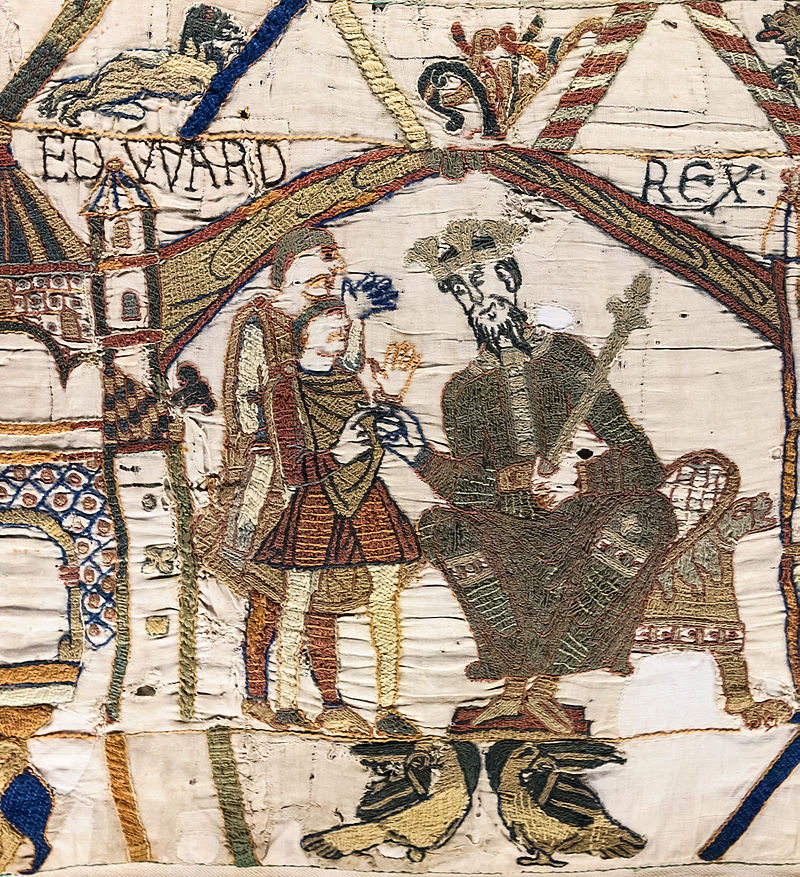Today is the feast of the Translation of St Edward the Confessor.
This evening the Oxford Oratory marked the day with Compline, a sermon and Benediction. we were encouraged in advance to pray for the conversion of England. St Edward is not only a national patron and patron of the monarchy, but he is also a local man, having been born at Islip, which lies to the north-east of Oxford.
St Edward the Confessor holding the ring returned by St John the Evangelist
From the Wilton Diptych
Image: catholicsaints.info
Compline was sung in the traditional Latin form by the clergy and the choir. The sermon was preached by Fr Jerome, who began by querying, but very respectfully, Mgr. Ronald Knox's assessment of St Edward as being, in temporal terms, a failure - the Mgr's sermon on St Edward is the second reading in today's Office of Readings.

St Edward the Confessor as shown on the Bayeux Tapestry
Image:Wikipedia
As King the Confessor reigned for almost as long as his four predecessors, died in possession of his throne, set an example of good government and pious care for the poor - symbolised by the story of his giving his ring to a beggar, who was in reality St John the Evangelist - and was married faithfully to his Queen, Edith. This example of a sustained if childless marriage was something Fr Jerome highlighted, with no doubt all the reports and rumours swirling round the current Synod in Rome in mind.
Gordon Plumb posted these stained glass images of St Edward on the Medieval Religion discussion group:
York Minster, Great East Window, 1d, left-hand figure c.1408:
https://www.flickr.com/photos/22274117@N08/17079983721
and detail:
https://www.flickr.com/photos/22274117@N08/17079223292
York Minster, Great East Window, 1d, arms of Edward the Cofessor c.1408:
https://www.flickr.com/photos/22274117@N08/17080737435
North Luffenham, St John the Baptist, 2c, early 14thC.:
https://www.flickr.com/photos/22274117@N08/21110955533
Cockayne Hatley, St John the Baptist, Bedfordhire, nIII, 1a early 14thC.:
https://www.flickr.com/photos/22274117@N08/2285002785
Wrangle, St Mary and St Nicholas, nVII, A 4, c.1410-30:
https://www.flickr.com/photos/22274117@N08/8170499758
York Minster, sXXXIV, 5c early 14thC, head 15thC.:
https://www.flickr.com/photos/22274117@N08/4934716140
Oxford, Balliol College Chapel, sIII, 1c, c.1529:
https://www.flickr.com/photos/22274117@N08/5901643848
Harpley, St Lawrence, Norfolk, wI, A6, 15th C.:
https://www.flickr.com/photos/22274117@N08/3320361898
Long Melford, Holy Trinity, Suffolk, nXVII (right-hand figure):
https://www.flickr.com/photos/22274117@N08/2230905801
Heydour, St Michael, Lincolnshire, nVI, 2a, c.1360:
https://www.flickr.com/photos/22274117@N08/3450473166
All of which makes me think that I really ought to get around to reading Frank Barlow's full biography of the King rather than just the shorter pieces by the Professor.


No comments:
Post a Comment